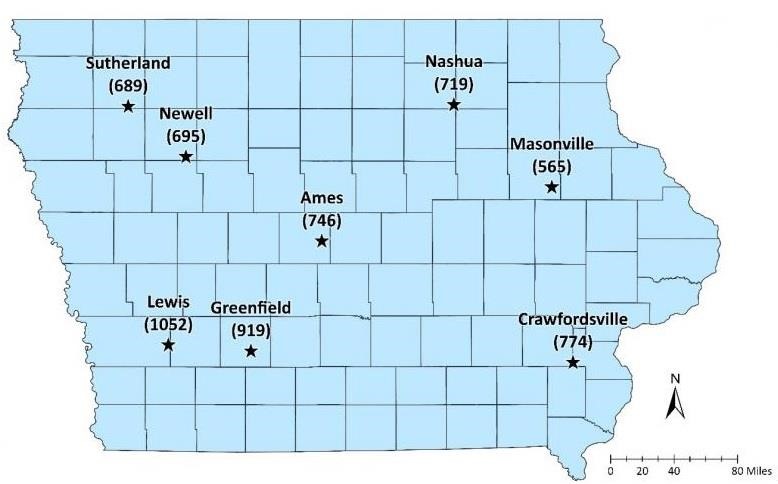By Ashley Dean and Dr. Erin Hodgson
Corn rootworm egg hatch in Iowa typically occurs from late May to the middle of June, with an average peak hatching date of June 6 in central Iowa. Development is driven by soil temperature and measured by growing degree days (GDDs). Research suggests about 50% of egg hatch occurs between 684-767 accumulated GDDs (since January 1; base 52°F, soil). Most areas within Iowa have reached peak egg hatch for corn rootworm (Figure 1), and we have heard several reports of larvae in cornfields.

Figure 1. Accumulated soil degree days (base 52°F) in Iowa as of June 18, 2024. Expect 50% egg hatch of corn rootworm between 684-767 degree days. Map courtesy of Iowa Environmental Mesonet, Iowa State University Department of Agronomy.
A severe corn rootworm larval infestation can destroy root nodes 4-6 (the nodes closest to the soil surface). Root pruning (Figure 2) reduces water and nutrient uptake and makes the plant unstable. Every node pruned to within 1 ½ inches of the stalk can result in 15% yield loss. Corn rootworm survival is greater when the soil is dry, and dry conditions can increase the yield impact of root pruning.
Regardless of practices used to suppress corn rootworm (e.g., crop rotation, Bt hybrids, or soil-applied insecticides), every corn field should be scouted for corn rootworm root injury to assess whether management tactics worked this spring. Fields in continuous corn production and areas with Bt trait performance issues in the past are the highest priority for inspection. Continue reading for an overview of scouting techniques, or watch this video to dive deeper into corn rootworm scouting and management.
Scouting for larvae
Farmers can assess larval activity in the field a few ways. One method is called the float test, and mid to late June is the best timing for this sampling method. This is when plants and surrounding soil are removed from the field and placed in a bucket of water. If there are larvae in the field, they will float to the surface. Be careful to distinguish corn rootworm larvae from other small, white worms or plant roots.
Similar to the float test, farmers can also dig up plants and the surrounding soil and place it on a black garbage bag or other dark surface. Gently sift around the soil and plant roots to find the white larvae. Read more about this method here.
Both the float test or simply looking for larvae are good for confirming the presence or absence of corn rootworm larvae and might help to diagnose issues with variant corn rootworms; however, these methods are not able to estimate yield losses or help with management decisions.
Looking at root injury
Assessing root injury while it is fresh is the best way to know the extent of corn rootworm larval injury in the field. It is ideal to look at corn roots 10-14 days after peak egg hatch, or just after feeding is done (usually when you start to see adults in the area). On some hybrids, corn roots can grow back and make it difficult to assess feeding injury later in the season. Use the ISU 0 to 3 Node Injury Scale to assess injury:
- Look at nodes 4-6 (the three nodes closest to the soil surface). For each node, count the number of roots pruned back to within 1.5 inches of the soil line or stalk and divide by the total number of roots on that node. Add the rating for all three nodes to achieve a final root rating.
- A rating of 0.25 is equal to the economic injury level.
- A rating of 0.50 is considered unacceptable by the Environmental Protection Agency (EPA) for pyramided transgenic hybrids (multiple belowground Bt traits or Bt + RNAi).
A more detailed description of how to assess root injury can be found in this blog article. Assessing root injury or looking for larvae in first year corn fields is the only way to confirm whether a variant population exists in the field (a population of either western or northern corn rootworm that is resistant to crop rotation).
Monitoring adult activity
We recommend looking for larvae and/or assessing root injury to understand the extent of larval feeding in the field but also to assess management tactics used this year. However, we also recommend that farmers use yellow sticky traps to monitor adult activity in the field to help make management decisions for the following growing season. The goal is to gain a representative sample of the field and to check traps during peak emergence. Consider multiple transects of traps and begin scouting 3-4 weeks after first adult emergence in the area. Capturing more than two beetles/trap/day is the threshold to consider a different management tactic next year (crop rotation or a different larval management tactic if corn will be planted). More information on trapping for adult corn rootworm and where to purchase traps can be found in this blog post or the corn rootworm IPM website. It is usually not economical to apply insecticide for adult control, so sticky trap monitoring should focus on making management decisions for the following growing season.
Source : iastate.edu